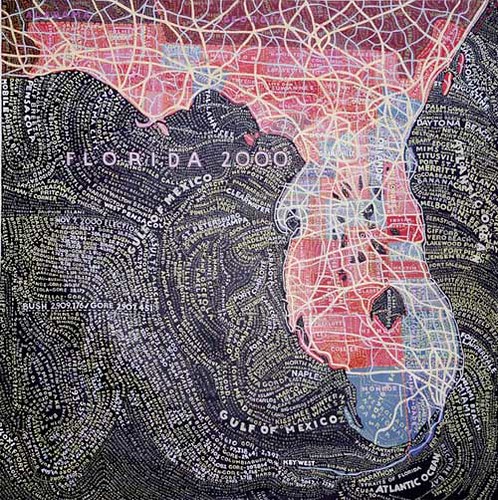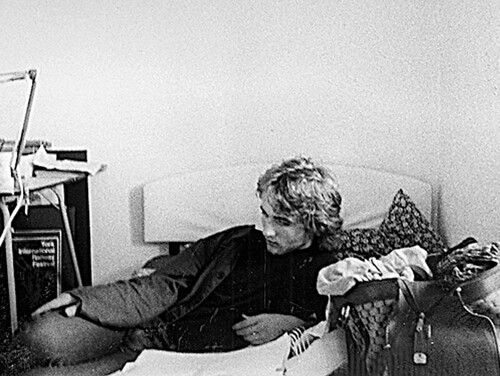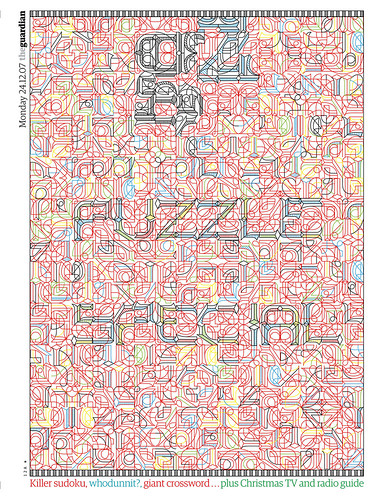Monday, 2:30pm
15 April 2013
No pressure
A glimpse at the ethos behind Alliance Graphique Internationale and the upcoming AGI Open London 2013

The public profile of the Alliance Graphique Internationale (AGI) is not especially high, which is a little surprising considering the members who belong to it, writes Tony Brook.
AGI was founded in 1951 as an elite club for designers and illustrators who saw the organisation as a way of sharing common interests and forging friendships across national and cultural borders.
Spread from Kenya Hara’s Designing Design, Lars Müller Publishers, 2007.
Top: Paula Scher’s intricate, opinionated maps.
These core motivations apply today as much as they did then. The modus operandi hasn’t changed either. An annual Congress is held in a different city, usually on a different continent. There are two parts to this gathering: AGI Open, a conference for students and professionals, and AGI Congress, a smaller members-only event.
But what keeps members from all over the world coming back to AGI Congress year after year, forking out small fortunes to attend? The obvious motivations apply: being part of something with such a great history; gaining inspiration from the speakers; experiencing a city from an insider’s perspective. But there is also a component that is less easily articulated – a genuinely collective spirit defined by friendship and camaraderie. This is without doubt what makes AGI Open and Congress so special. We, the members, are the event. We receive no fees and give our time for the sole purpose of contributing to the greater good.
Identity for the Barcelona 2011 AGI Open and AGI Congress, based on the SuperVeloz modular font system. Pablo Martín in collaboration with Astrid Stavro, Mario Eskenazi, Patrick Thomas and the the rest of the AGI Spain team.
So how do you become a member? I remember sketching out a possible career path at college. I started at the top naturally, with the Alliance Graphique Internationale. I imagined a couple of swarthy Greek gods, Alan Fletcher and Saul Bass, reclining on the sunlit summit of Mount Olympus discussing matters of great import. I discounted this possibility, and moved down a notch. What if I could win a Yellow Pencil? What if I could get in the D&AD annual? I tried to picture the spread with my award-winning work on it, but it was blank and I blushed. I lowered my sights again, this time to somebody, somewhere, paying me to design something, once.
I didn’t give another thought to AGI until one day in 2006 when Hamish Muir called to ask if I was interested in being put forward for consideration to the UK chapter. It seems that Alan Fletcher had suggested that I might be worth a look. That’s how it happens. You submit a portfolio to an international jury (members of the jury change every year), and if they judge you fit for membership, you’re in.
A younger Tony Brook.
I have to confess that after I put the phone down I went straight off to try to locate the website in order to fill in the huge gaps in my knowledge. A suitably intimidating list awaited: Cassandre, Crouwel, Vignelli, Hofmann, Lubalin, Kamekura, van Toorn … Jesus Christ! Well not him, but pretty much everyone else.
Happily, I also found that there were members who didn’t quite possess the god-like status of Josef Müller-Brockmann. So, I reckoned I had a slim chance, but a chance nonetheless. To cut a long story short, I got in. Does this make me as good as the luminaries mentioned? No. But I’d be lying if I said it wasn’t a thrill to be in their company.
Tony Brook.
So, fast-forward to now. I’m no longer the skinny, spotty downbeat realist living in a hovel in Taunton. I’m more than a little larger and much balder. On the bright side, I’ve chewed the fat with Massimo and Wim; I’ve hugged Paula and Stefan; laughed like a drain with Jan; sat in awe of Kenya; and had the pleasure of squirting Marian B with a water pistol.
I’m currently serving as President of the UK chapter (President Tony!)
and have just completed four fabulous years on the International Executive Committee (IEC), which manages AGI, primarily under the wonderfully refreshing and reforming Presidency of Paula Scher. The UK chapter has been charged with putting on the biggest and best AGI Open (and Congress) we’ve ever had. No pressure. Fortunately I have a fantastic board including Angus Hyland, Jeremy Leslie, Domenic Lippa, Sean Perkins and Adrian Shaughnessy who have all made, and are making, a great contribution.
So the current IEC, consisting of Marian Bantjes, Kenya Hara, David Smith, Patrick Thomas, Elisabeth Kopf and Lars Müller have rubber-stamped AGI Open London, and it is going to be blinding. Given this, you would have to ask what could possibly make AGI better? Well, we could start with a lot more female members, and members from the Asian sub-continent and other under-developed areas. More members from screen-and web based-design would also be good. Fortunately we are well aware of our shortcomings as a club and are acting upon them, while upholding the club’s standards. The future of AGI feels vibrant and purposeful.
Marian Bantjes Christmas ‘Puzzle Series’ cover for the Guardian’s G2 section, 2007. Art director: Richard Turley.
Read ‘AGI Open – the “graphic design World Cup”?’ on the Eye blog.
See also Ursula Held’s ‘Form follows attitude’ about Lars Müller from Eye 20, David Barringer’s review ‘Cool as a Muji candle in the snow’ of Kenya Hara’s book Designing Design in Eye 66 and ‘Reputations: Marian Bantjes’ by John L. Walters from Eye 72.
Eye is the world’s most beautiful and collectable graphic design journal, published quarterly for professional designers, students and anyone interested in critical, informed writing about graphic design and visual culture. It is available from all good design bookshops and online at the Eye shop, where you can buy subscriptions and back issues. You can see what Eye 84 looks like at Eye before You Buy on Vimeo.





